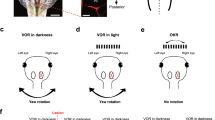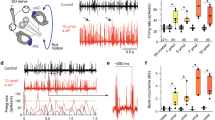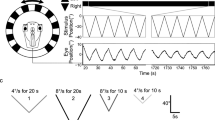Summary
In the clawed toad,Xenopus laevis, the static vestibulo-ocular reflex appears in 3 days old tadpoles (developmental stage 42) (Fig. 2). The amplitude and gain of this reflex increase up to stage 52, and then decrease to an almost constant value at stage 60 and older tadpoles (Fig. 3). The most effective roll angle gradually increases during development (Fig. 4).
The size of the sensory epithelia reaches the final value at the end of the premetamorphic period (stage 56) (Fig. 5). The small-cellular medial ventral vestibular nucleus (VVN) reaches its maximal number of neurons before the large-cellular lateral VVN. Cell death is more pronounced in the medial than in the lateral part of the VVN. In the dorsal vestibular nucleus (DVN), the numerical development of the small and large neurons is similar to that in the small-cellular medial and large-cellular lateral portion of the VVN (Fig. 7).
The results demonstrate that labyrinth and oculomotor centres are anatomically connected before the labyrinth and the vestibular nuclei are fully developed. We discuss the possibility that the ciliary polarity pattern of the sensory epithelium is radial during the first period of life, and changes to the vertebrate fan-type pattern during the second week of life. According to the increase of gain during the first three weeks of life, an increase of the spontaneous activity of vestibular neurons may occur during this period.
Similar content being viewed by others
Abbreviations
- α :
-
eye angle
- γ :
-
roll angle
- α(γ) :
-
response characteristic
- A :
-
response amplitude
- G :
-
response gain
- VOR :
-
vestibulo-ocular reflex
- VVN :
-
ventral vestibular nucleus
- DVN :
-
dorsal vestibular nucleus
References
Anniko M (1983) Embryonic development of vestibular sense organs and their innervation. In: Romand R (ed) Development of auditory and vestibular systems. Academic Press, New York London, pp 375–423
Budelmann B-U (1970) Die Arbeitsweise der Statolithenorgane vonOctopus vulgaris. Z Vergl Physiol 70:278–312
Budelmann B-U (1979) Hair cell polarization in the gravity receptor systems of the statocysts of the cephalopodsSepia officinalis andLoligo vulgaris. Brain Res 160:261–270
Cohen B (1974) The vestibulo-ocular reflex arc. In: Kornhuber HH (ed) The vestibular system. Part 1: Basic mechanisms. (Handbook of sensory physiology, vol VI/1). Springer, Berlin Heidelberg New York, pp 477–540
Corwin JT (1983) Postembryonic growth of the macula neglecta auditory detector in the ray,Raja clavata: continual increases in hair cell number, neural convergence, and physiological sensitivity. J Comp Neurol 217:345–356
Curthoys JS (1983) The development of function of primary vestibular neurons. In: Romand R (ed) Development of auditory and vestibular systems. Academic Press, New York London, pp 425–461
Dieringer N, Precht W (1982) Compensatory head and eye movements in the frog and their contribution to stabilization of gaze. Exp Brain Res 47:394–406
Ginzberg RD, Gilula NB (1980) Synaptogenesis in the vestibular sensory epithelium of the chick embryo. J Neurocytol 9:405–424
Graf W, Baker R (1983) Adaptive changes of the vestibuloocular reflex in flatfish are achieved by reorganization of central nervous pathways. Science 221:777–779
Gregory KM (1972) Central projection of the eight nerve in frogs. Brain Behav Evol 5:70–88
Hess BJM, Knöpfel T, Precht W (1984) Dynamics of maculo-ocular reflexes in the frog. Neuroscience 11:645–650
Holst E von (1950) Die Arbeitsweise des Statolithenapparates bei Fischen. Z Vergl Physiol 32:60–120
Horn E, Rayer B (1978) Compensation of vestibular lesions in relation to development. Naturwissenschaften 65:441
Horn E, Rayer B (1980) A hormonal component in central vestibular compensation. Z Naturforsch 35c:1120–1121
Jacobson M (1978) Developmental neurobiology. Plenum Press, New York London
Knöpfel T, Hess BJM, Precht W (1984) Responses of frog trochlear motoneurons to linear acceleration. J Comp Physiol A 154:233–240
Konigsmark BW (1970) Methods for counting neurons. In: Nauta WJH, Ebbesson SOE (eds) Contemporary research methods in neuroanatomy. Springer, Berlin Heidelberg New York, pp 315–340
Lang HG, Horn E (1980) The development of the static vestibulo-ocular reflex inXenopus. Z Naturforsch 35c:1122–1123
Lannou J, Precht W, Cazin L (1983) Functional development of the central nervous system. In: Romand R (ed) Development of auditory and vetibular systems. Academic Press, New York London, pp 463–478
Lowenstein O, Roberts DM (1949) The equilibrium of the otolith organs of the thornback ray (Raja clavata). J Physiol (Lond) 110:392–415
Matesz C (1979) Central projection of the VIIIth cranial nerve in the frog. Neuroscience 4:2061–2071
Mehler WR (1972) Comparative anatomy of the vestibular nuclear complex in submammalian vertebrates. Prog Brain Res 37:55–67
Neil DM (1975) Statocyst control of eyestalk movements in mysid shrimps. In: Schöne H (ed) Mechanisms of spatial perception and orientation as related to gravity. Fortschr Zool 23. Gustav Fischer, Stuttgart, pp 98–109
Nieuwkoop PD, Faber J (1975) Normal table ofXenopus laevis (Daudin). Hubrecht Laboratory, Utrecht
Precht W (1974) Physiological aspects of the efferent vestibular system. In: Kornhuber HH (ed) The vestibular system. Part 1: Basic mechanisms. (Handbook of sensory physiology VI/1). Springer, Berlin Heidelberg New York, pp 221–236
Precht W (1976) Physiology of the peripheral and central vestibular system. In: Llinás R, Precht W (eds) Frog neurobiology. Springer, Berlin Heidelberg New York, pp 481–512
Rayer B, Cagol E, Horn E (1983) Compensation of vestibular induced deficits in relation to the development of the Southern Clawed Toad,Xenopus laevis Daudin. J Comp Physiol 151:487–498
Romand R, Dauzat M (1982) Modification of spontaneous activity in primary vestibular neurons during development in the cat. Exp Brain Res 45:265–268
Romeis B (1968) Mikroskopische Technik. Oldenburg, München Wien
Sachs L (1974) Angewandte Statistik. Springer, Berlin Heidelberg New York
Schöne H (1954) Statocystenfunktion and statische Lageorientierung bei decapoden Krebsen. Z Vergl Physiol 36:241–260
Schöne H (1964) Über die Arbeitsweise der Statolithenapparate bei Plattfischen. Biol Jahresheft 4:135–156
Schöne H (1975) On the transformation of the gravity input into reactions by statolith organs of the “fan” type. In: Schöne H (ed) Mechanisms of spatial perception and orientation as related to gravity. Fortschr Zool 23. Gustav Fischer, Stuttgart, pp 120–127
Shelton PMJ (1970) The lateral line system at metamorphosis inXenopus laevis Daudin. J Embryol Exp Morphol 24:511–524
Tegetmeyer H, Schwartze P (1982) Tonic vestibular control of eye position in postnatal developing rabbits. Acta Otolaryngol 94:289–297
Thornhill RA (1972) The development of the labyrinth of the lamprey (Lampetra fluviatilis Linn. 1758). Proc R Soc Lond B 181:175–198
Traill AB, Mark RF (1970) Optic and static contributions to ocular counter-rotation in carp. J Exp Biol 52:109–124
Wersäll J, Bagger-Sjöbäck D (1974) Morphology of the vestibular sense organ. In: Kornhuber HH (ed) The vestibular system. Part 1: Basic mechanisms. (Handbook of sensory physiology, vol VI/1). Springer, Berlin Heidelberg New York, pp 123–170
Will U, Luhede G, Görner P (1985a) The area octavo-lateralis inXenopus laevis. I. The primary afferent projections. Cell Tissue Res 239:147–161
Will U, Luhede G, Görner P (1985b) The area octavo-lateralis inXenopus laevis. II. Second order projections and cytoarchitecture. Cell Tissue Res 239:163–175
Young JZ (1960) The statocysts ofOctopus vulgaris. Proc R Soc Lond B 152:3–29
Author information
Authors and Affiliations
Rights and permissions
About this article
Cite this article
Horn, E., Lang, H.G. & Rayer, B. The development of the static vestibulo-ocular reflex in the Southern Clawed Toad,Xenopus laevis . J. Comp. Physiol. 159, 869–878 (1986). https://doi.org/10.1007/BF00603740
Accepted:
Issue Date:
DOI: https://doi.org/10.1007/BF00603740




